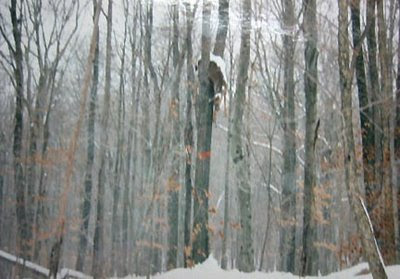The Very First Hominin


The Park info also tells us that the location around the Steppes region is mirrored across the Bering into the rough, wild lands of the Nearctic in North America in an area termed the Mammoth Steppe, a complex biome that changed over time and across the region. This resulted in a mosaic-like ecosystem that varied in response to a constantly changing climate (recall also that multi-biome map from part 1). During the Pleistocene, the climate changed much more dramatically than it has during the last 10,000 years, the period known as the Holocene, a remarkably stable climatic period compared to the preceding million years or so. The unstable climate of the Pleistocene caused rapid changes in the plant communities and thus forage for megafaunal herbivores. Abundance and distributions of these animals would have varied in response to the changes. Being large, the megafauna would have been able to move across the landscape tracking favorable patches of habitat both seasonally and over longer time scales.

Looking at cave painting locations, we can see where ice-age beings spent their time, traveling with the melting ice of the Pleistocene, starting at our
most recent find of the oldest dated painting to this day in Indonesia. The cave has been trying to reclaim this work
for over 49,000 years, but we don't know how long between the
work and the reclaiming process began.
The article also suggests "This was a complete ecosystem of megafauna with herbivores and the predators that consumed them. Like most ecosystems, there were many more herbivores than carnivores. The giant short-faced bears may have mostly scavenged already-dead herbivores, but brown bears, lions, and wolves undoubtedly hunted and killed their prey. Radiocarbon dates suggest the lions may have specialized in hunting horses." The preference for these fast running animals is reflected in the sheer number of horses painted in caves outweighs all other animals depicted in cave paintings. There are many "schools of the art as well, some artist critics noting that some of the artworks display perspective not seen in western art until the fifteenth century.
This author may not be far off, as a great many animals used the Nearctic biome as their new home once the ice bridge melted. There are lots of unanswered questions as to why and how most have disappeared, but we know for a fact not all have. We know about the animals that are easier to see, claiming nothing else officially exists until one day modern science is faced with their existence, left to examine why the real struggle of scientific hubris fostered our ignorance. So what if a small cloister of intelligent animals watched humans eventually blossom and grow, saw their petty little ways, and rejected technology for a life in harmony with nature? Is it uncomfortable because they don't pay taxes? Or submit to rule of law? Don't like being harassed, photographed, angry at loss of land and food resources, maybe feeling the heat of global warming... ?
The dodo and thylacine may have gone down as myth or heresay, without the very few extant videos and photos in poor condition. There is no scientific weight given to eyewitnesses or legend, no matter the persons swearing it. Evidence accepted thus far as proof of existence has had dramatic recent breakthroughs, including the acknowlegement of a species of giant eel from Loch Ness, by simple DNA collected in a manner science is terming E-DNA, or Environmental DNA (very exciting! but again shall not be explained here). In an article from the journal PLOS Biology it is predicted that more than 80 percent of species on Earth are still awaiting discovery; and at some point, we used to ascribe to myth the platypus, the narwhal, the gorilla, the giant squid, the Vietnamese "gill" deer, and the rhinocerous. Before 1938, the coelacanth was last seen in fossils with the dinosaurs, 65 mya, and we have seen them live now many times, and caught almost 10, with experts and special equipment. And then there is this highly respected, trustworthy, meritorious and honorable fighter ace in the RAF during WWII, going on to hold several high positions and missions, who happened to snap this authenticated photo of what appears to be a titanoboa, missing from the fossils since the Paleocene, which is some millions of years more recent than when the coelacanth was last found:
How are we absolutely, positively, 100% certain that there is NO CHANCE that even with millions of years of pith and sapiens overlap and mix, that one or more pith cultures could have possibly migrated from their established habitat in the Paleo-arctic of the Steppes area, swivel-hip gliding their way across land and ice bridges, following their favorite food to a similar environment called the Nearctic -- and may just have the right family sizes to thrive in the most wild and humanly uninhabitable of places, tending their flocks in ways that were ancient before we sapiens began to thrive in pockets of warm, fuzzy places. Wouldn't we have seen things, heard stories, had evidence by now?
Coming soon: Part 3, The Evidence










No comments:
Post a Comment